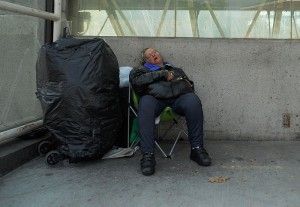L.A. Sheriffs set the standard for dealing with the homeless
 Editor’s note: This is the second part of a three-part series on how the homeless and mentally ill are treated in California. Part One was about the Kelly Thomas beating and death.
Editor’s note: This is the second part of a three-part series on how the homeless and mentally ill are treated in California. Part One was about the Kelly Thomas beating and death.
July 9, 2012
By Tori Richards
Welcome to 450 Bauchet St., a 10-acre compound in the heart of downtown Los Angeles that is the world’s biggest jail.
Known as Twin Towers, it has a population greater than many small towns, with 3,911 inmates, 900 staff, and even its own hospital.
But it also has another distinction: the world’s largest mental institution.
Housed in one wing and encompassing four floors, the mental health ward tends to approximately 1,200 inmates with psychiatric problems. Several hundred more of the most severe cases are located in the hospital.
California is now a state where the police — not doctors or counselors — are the front lines to millions of mentally ill who have no other recourse than to end up in the jails.
“Sheriff Baca has frequently commented that the mentally ill belong in a mental institution,” said Capt. Mike Parker. “In law enforcement we deal with things because other aspects of society have failed. You have a system not addressing the need. “In the end, law enforcement is the last stop. We’re not looking for that responsibility; it was given to us.”
A breakdown in the system has led to a large population of the mentally ill who turn to crime or simply wander the streets homeless, a recipe for disaster.
Just look at the case of Kelly Thomas, a 37-year-old schizophrenic homeless man who belonged in a mental care facility rather than on the streets.
His run-in with Fullerton police one year ago resulted in his beating death at the hands of officers ill equipped to deal with a person who had a mental disability.
In California, the severely mentally ill are four times more likely to be in jail than a hospital or clinic, a recent report found.
A task force comprised of doctors, lawyers and mental health organizations completed the 30-month study and released their report in March. It criticized the state for its failures, mentioning Thomas as an example where little has been done to safeguard rights, protect the mentally ill and provide prompt treatment.
The study found that mental illness accounts for 33 percent of the homeless, 20 percent of incarcerated inmates and death comes 25 years earlier than the general population.
How It Got This Way
In 1968, the California Legislature passed a law that required a judge’s order to involuntarily commit mental patients as an end to the earlier horrors where people were thrown into institutions against their will, never to emerge.
The law also ordered counties to open treatment centers and promised matching state funds of 90 percent to assist in paying for a host of new drugs that tamed psychoses, effectively keeping many would-be patients out of institutions.
In keeping with this mandate, Gov. Ronald Reagan started closing state-run mental hospitals and vetoed measures that would pass that funding on to the counties so they could deal with the issue locally.
Then Reagan became president and he slashed aid to mental health programs effectively ending any federally sponsored clinics. The burden was almost entirely on local jurisdictions.
But most counties lacked the resources to start their own programs. More and more people decided to live on the streets when they weren’t getting regular medication.
Voters approved Proposition 63 in 2004, the Mental Health Services Act, which raised taxes 1 percentage point on those making $1 million or more a year; and earmarks $1 billion a year for services. Gov. Jerry Brown also promised to overhaul the mental health system when he was elected, but the state continues to operate in the red.
A current law that expires this year may be extended, allowing judges to order the mentally ill to take medication and to receive outpatient recovery.
A Novel Approach
As the burden of caring for psychiatric patients began shifting to local communities, the Los Angeles County Sheriff’s Department took notice. A leader in law enforcement, it became the first agency in the nation to dedicate police officers to specifically help the mentally ill.
“We receive training regarding dealing with the mentally ill; there is the unpredictability factor,” Parker said. “This is a very complex issue; it’s not quickly solved even with money or resources. It has to do with human rights vs. the right to not be forced to go into a mental institution. That’s the way the law is right now.”
Law enforcement straddles the line between a) helping people who are deemed unfit under Section 5150 of the state Welfare and Institutions Code — a danger to themselves, others, or gravely disabled; and b) and someone who is mentally ill but has committed a crime.
Both segments can be detained, the former for up to 72 hours at a mental facility and the latter in a jail cell awaiting a decision by the district attorney whether to file charges.
“Psychiatrists and psychologists work years to where they get a doctorate to deal with this issue in a controlled setting,” Parker said. “What does law enforcement get?”
The mental ward at Twin Towers is comprised of inmates who have committed felonies. An average length of stay is 50 days, so, “It’s not a lot of time to heal something,” Parker said.
About 20 years ago, the Sheriff’s Department initiated the Mental Evaluation Team, which has deputies assigned to handle calls involving people exhibiting psychological problems. It was the first such program in the nation.
Five deputies are partnered with clinicians from the county health department to get the mentally ill the help they need.
Deputy Greg Plamondon has been assigned to the unit for 17 years. He has won his department’s Humanitarian Award for going beyond the scope of his job. Most notably:
* An elderly woman who was living in filth and couldn’t deal with reality when her dog died was taken to a mental hospital by Plamondon. He brought her valuables with her and visited her there until she died six months later.
* A homeless man with a long history of mental illness had severe leg infections, so Plamondon had him committed to a psychiatric hold so that he could get care. Sometime later Plamondon saw him again and the wounds were worse, so the deputy spent months trying to learn his identity and Social Security number so the man could get benefits. The man later moved into a nursing facility.
* Plamondon was asked to locate a woman’s brother who was living on the streets. He was found on a curb in the pouring rain, unable to care for himself and suffering from hypothermia. Plamondon placed him on an involuntary hold so he could get medical and psychological help. The man ended up staying 30 days.
It takes longer
“A lot of officers don’t want to deal with this; it takes a little bit longer than a regular call and you need patience,” said Plamondon one afternoon after he had spent the entire day dealing with a man who had been making terrorist threats. “It’s a good fit for me; I like talking to people.”
He said he has a rapport with the mentally ill that he meets on the streets and often runs into the same people.
“About 75 percent of the homeless have some sort of diagnosis of mental illness,” he said. “It’s rare to convince them to get off the street. On several occasions, we’ve been able to get them into a board and care where they have food and shelter provided for them instead of shagging cans at risk of getting beaten up or worse by someone who doesn’t want them around.”
Part Three Coming Soon: A government review organization issues its use of force report on the Kelly Thomas death.
Related Articles
Lawsuit could bring ‘social justice’ to adult-first K-12 school districts
The left in California has been slow to understand that having a state government devoted to the interests of the
McClintock: Water Actually 'Abundant'
JUNE 2, 2011 By JOHN SEILER The history of California practically is the history of water. So it’s not surprising
San Fran Is Pension Ground Zero
SEPT. 28, 2010 By DAVE ROBERTS SAN FRANCISCO — San Francisco’s 26,000 city government employees have had it pretty good



